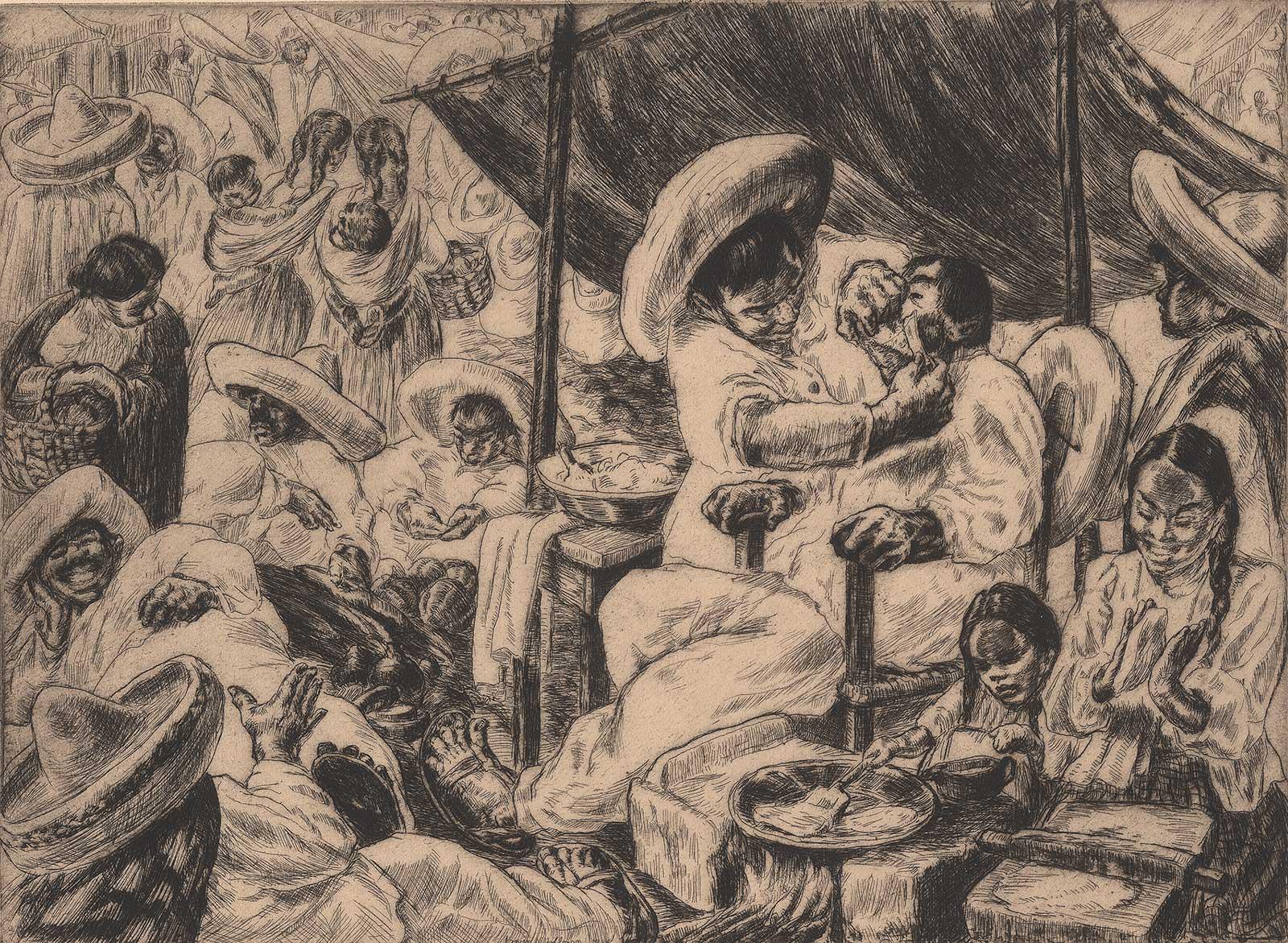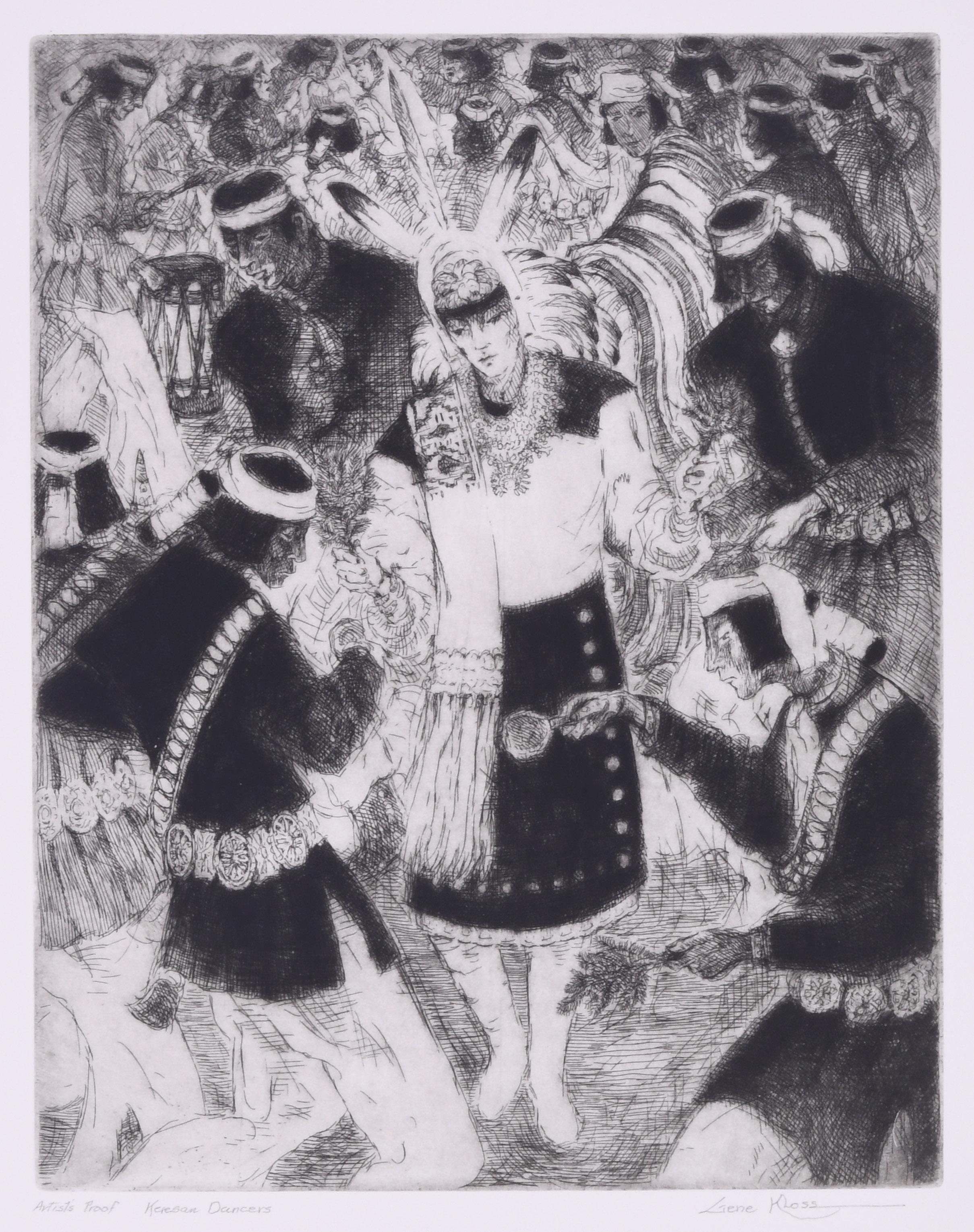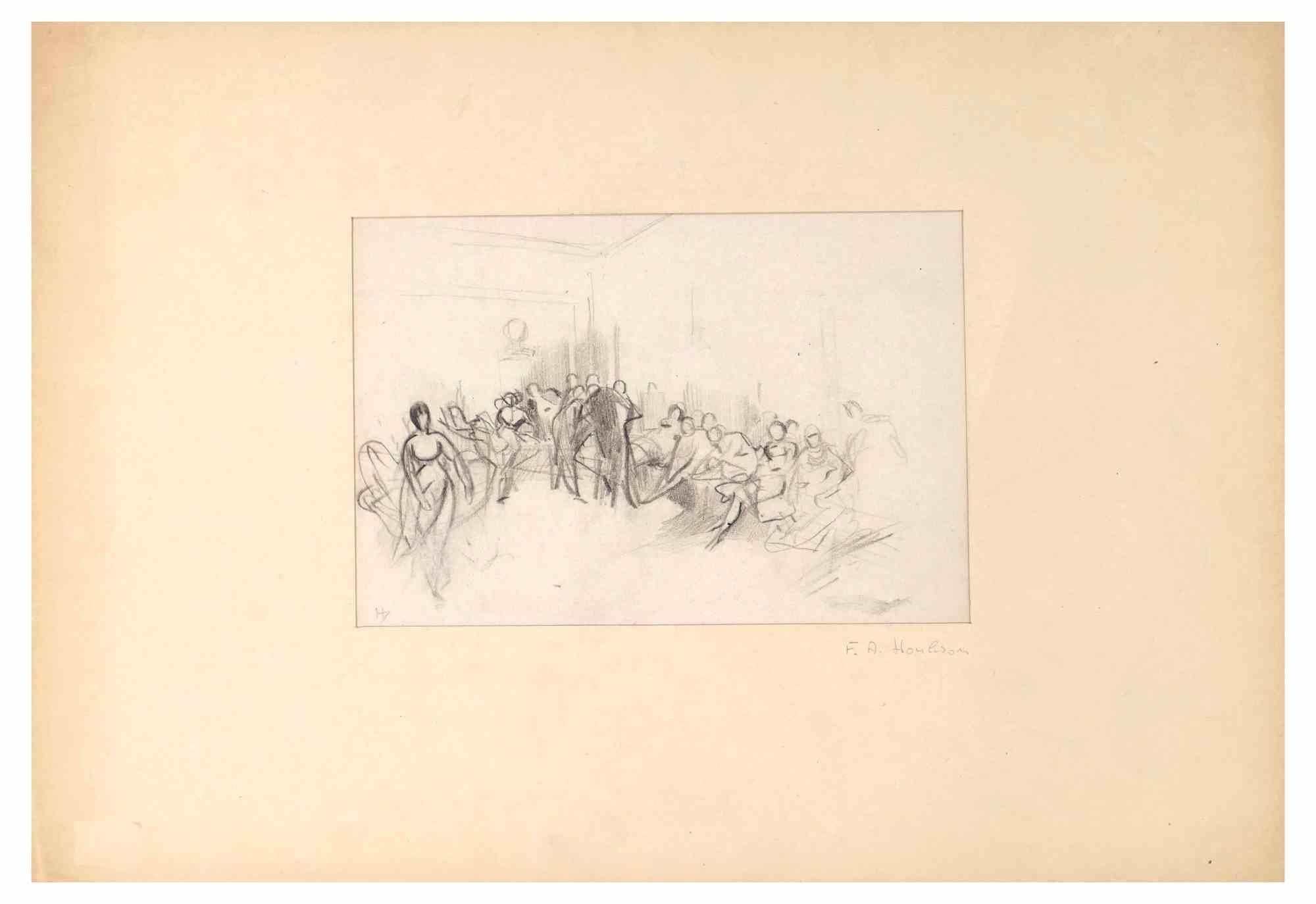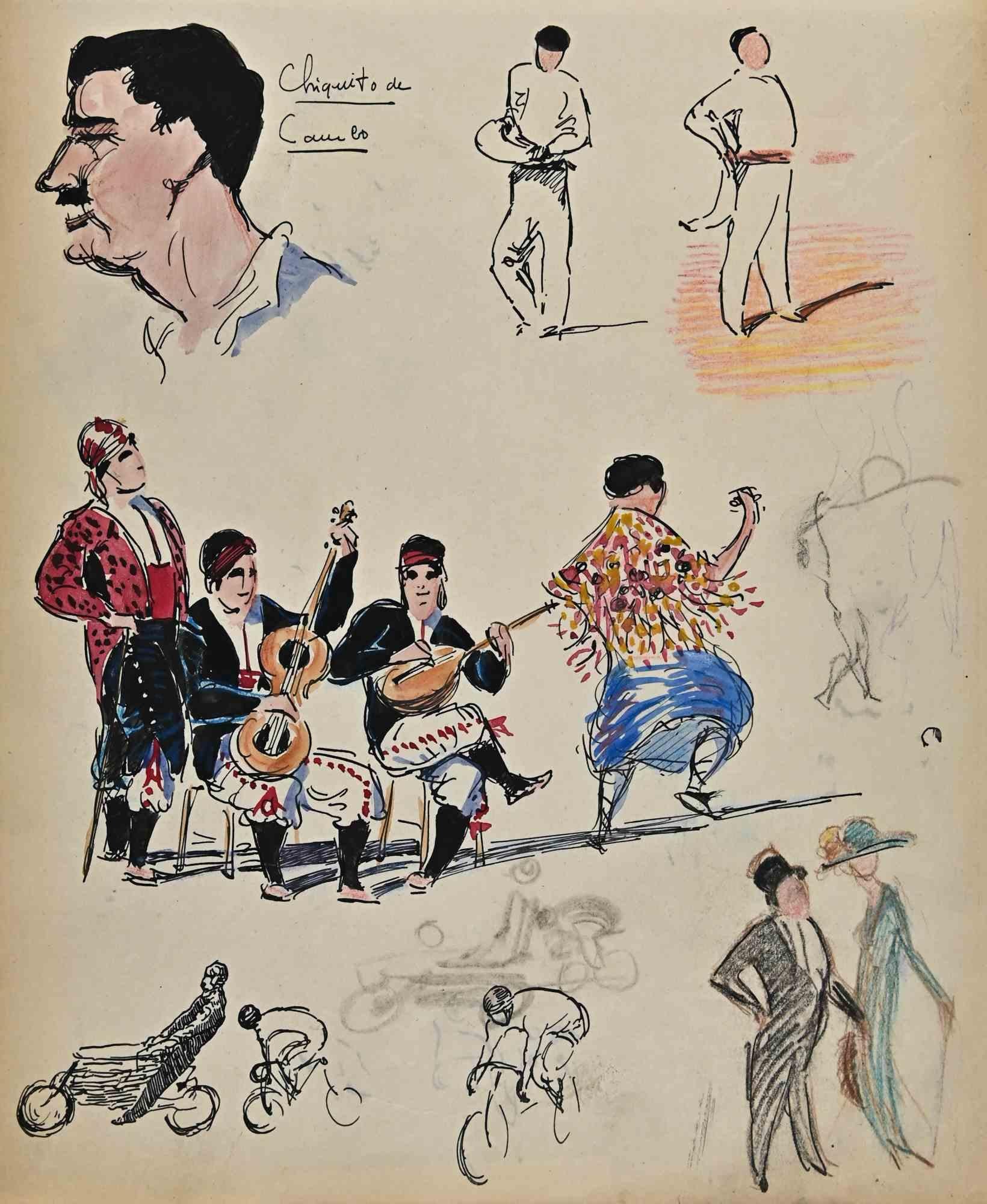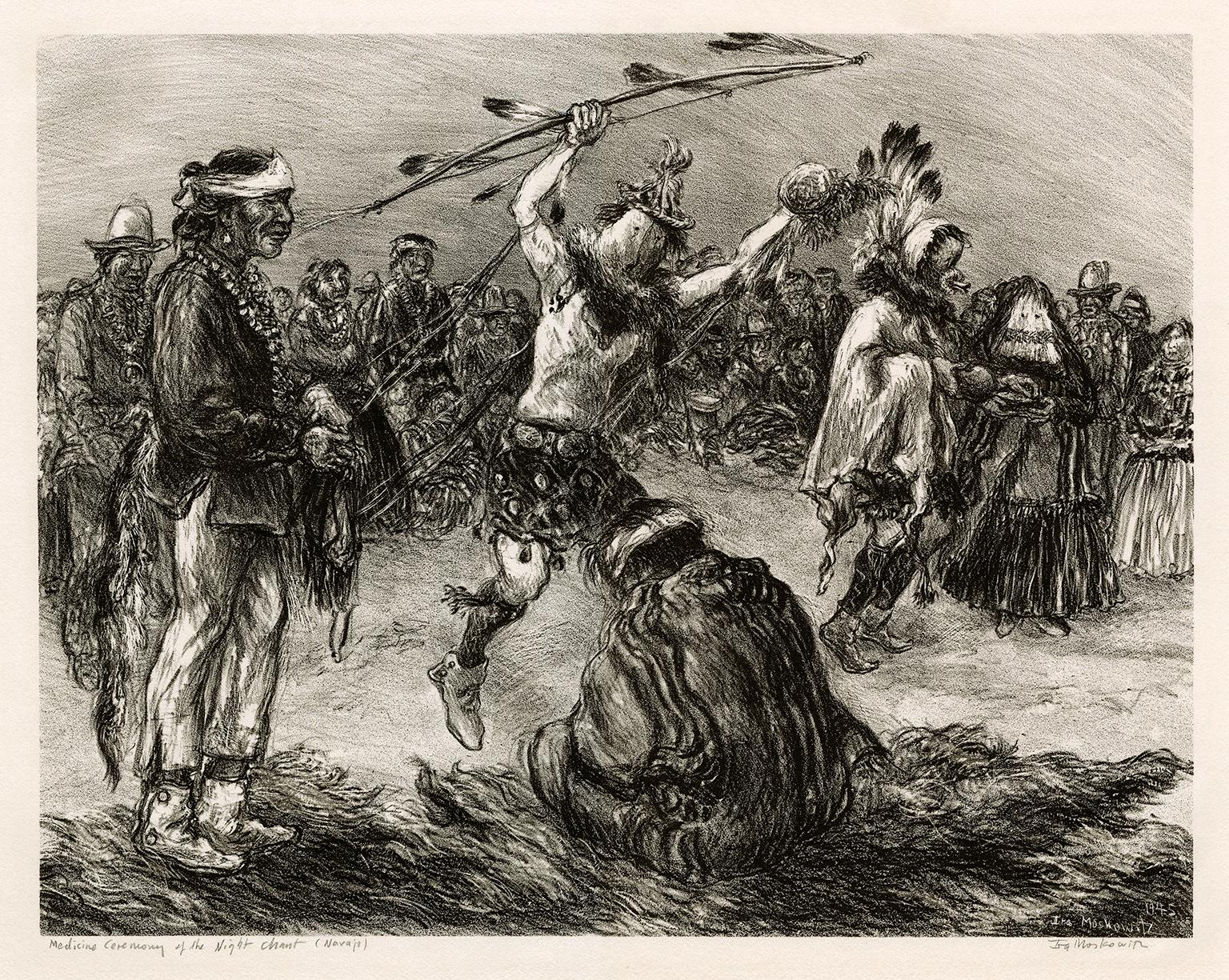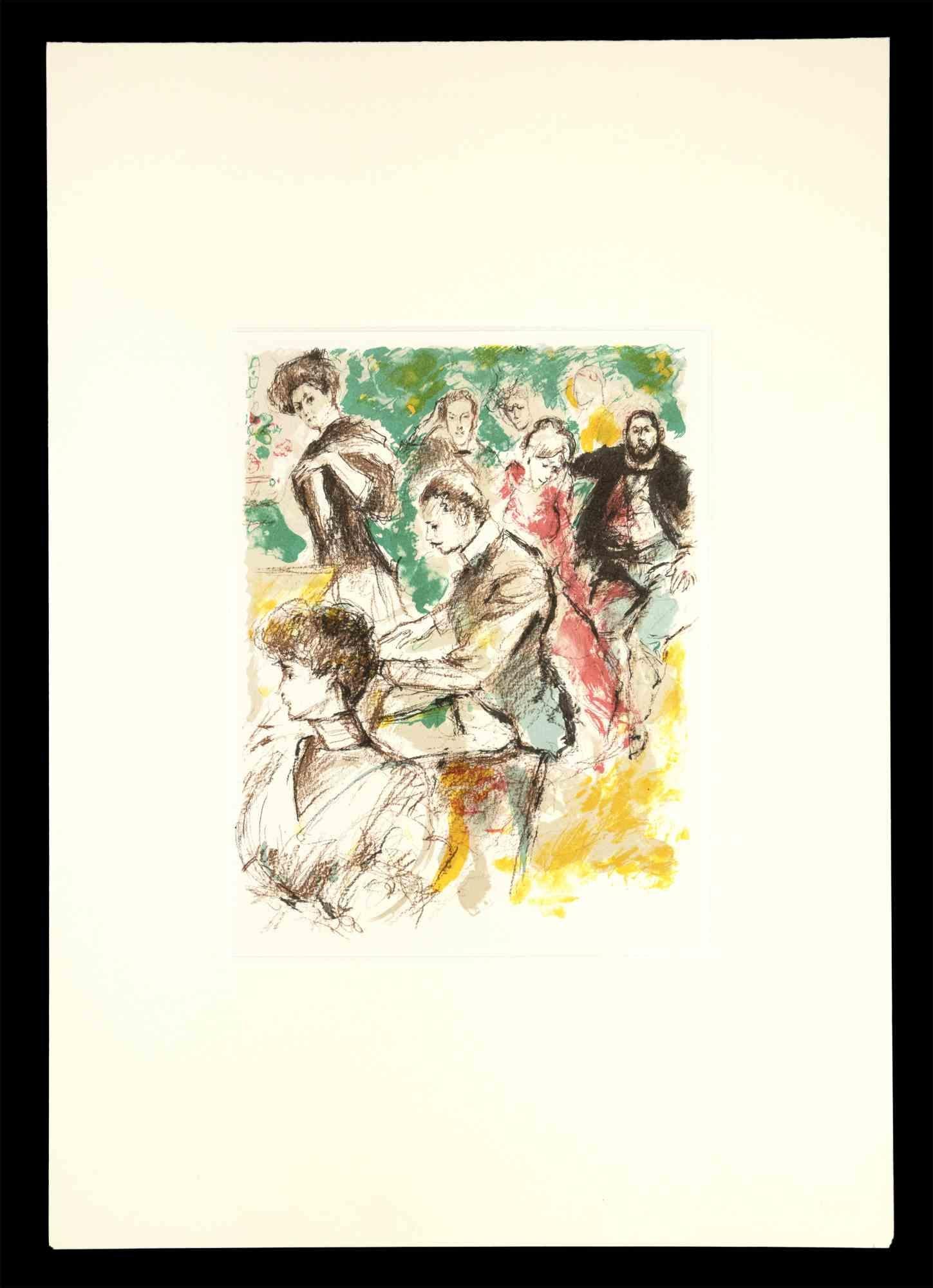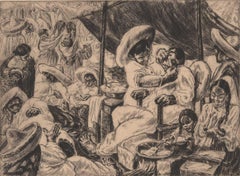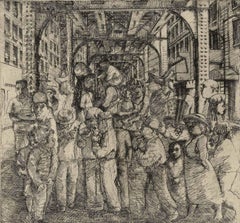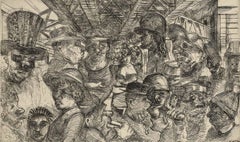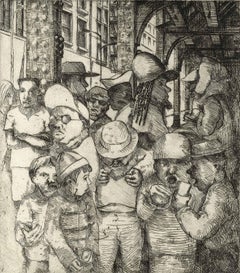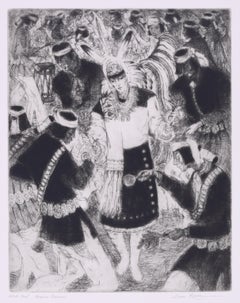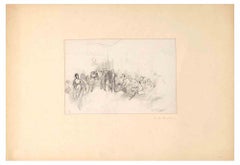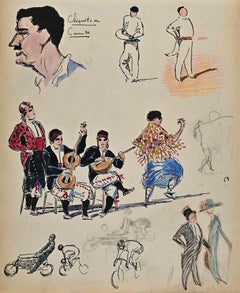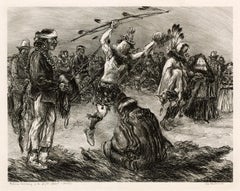Items Similar to Mexican Orchestra (joy of the people is captured in this celebratory festival)
Want more images or videos?
Request additional images or videos from the seller
1 of 8
George Overbury HartMexican Orchestra (joy of the people is captured in this celebratory festival)1929
1929
$476
$75036% Off
£361.02
£568.8336% Off
€414.64
€653.3236% Off
CA$681.94
CA$1,074.4836% Off
A$750.76
A$1,182.9236% Off
CHF 383.72
CHF 604.5936% Off
MX$8,960.54
MX$14,118.4936% Off
NOK 4,885.52
NOK 7,697.7736% Off
SEK 4,571.76
SEK 7,203.4036% Off
DKK 3,097.13
DKK 4,879.9336% Off
About the Item
"Mexican Orchestra" is one of the George Overbury Hart's largest pieces. It is #14 from a limited edition of 50. The image captures a festive event with hanging lanterns, an orchestra, people cooking -- multiple figures performing joyful tasks.
Permanent Collection of the Metropolitan Museum and the Museum of Modern Art, National Gallery of Art, Chicago Art Institute and the Brooklyn Museum. Hart lived for a time with artist Jules Pascin in New Orleans. The building is the Pontalba Apartments overlooking the St. Louis Cathedral on Jackson Square. This piece was illustrated in Albert Reese's American Prize Prints of the 20th Century
George Overbury Hart was born in Cairo, Illinois. He left home at an early age and supported himself with odd jobs. From 1907 to 1912 he painted signs at amusement parks in the New York City area. During the next decade, he painted stage sets for motion picture studios in Fort Lee, New Jersey. As his paintings and prints gained serious recognition, his reputation grew.
Known simply as "Pop," Hart spent most of his life traveling the world. In South America, Iceland, the South Seas, Mexico, and Europe, Hart captured scenes of everyday life in casual, lively watercolors. Late in his career, this self-taught artist turned to lithographs and etchings. Museums began to acquire his work in the 1920s.
- Creator:George Overbury Hart (1868-1933, American)
- Creation Year:1929
- Dimensions:Height: 22 in (55.88 cm)Width: 28.25 in (71.76 cm)
- Medium:
- Movement & Style:
- Period:
- Condition:
- Gallery Location:New Orleans, LA
- Reference Number:1stDibs: LU84134461742
About the Seller
4.9
Recognized Seller
These prestigious sellers are industry leaders and represent the highest echelon for item quality and design.
Gold Seller
Premium sellers maintaining a 4.3+ rating and 24-hour response times
Established in 1988
1stDibs seller since 2018
805 sales on 1stDibs
Typical response time: 6 hours
Associations
International Fine Print Dealers Association
- ShippingRetrieving quote...Shipping from: New Orleans, LA
- Return Policy
Authenticity Guarantee
In the unlikely event there’s an issue with an item’s authenticity, contact us within 1 year for a full refund. DetailsMoney-Back Guarantee
If your item is not as described, is damaged in transit, or does not arrive, contact us within 7 days for a full refund. Details24-Hour Cancellation
You have a 24-hour grace period in which to reconsider your purchase, with no questions asked.Vetted Professional Sellers
Our world-class sellers must adhere to strict standards for service and quality, maintaining the integrity of our listings.Price-Match Guarantee
If you find that a seller listed the same item for a lower price elsewhere, we’ll match it.Trusted Global Delivery
Our best-in-class carrier network provides specialized shipping options worldwide, including custom delivery.More From This Seller
View AllMexican Barber Shop (Getting a shave amidst revelry of community)
By Irwin D. Hoffman
Located in New Orleans, LA
Irwin Hoffman created a lively scene of a Mexican barber shop that serves as a focal point of the community's life. A man is being shaved as people cook, eat and revel in the camaraderie of the scene. This print was issued by Associated American Artists and is in the permanent collection of the San Francisco Museum of Art.
Born in East Boston...
Category
1930s American Modern Figurative Prints
Materials
Etching
$400 Sale Price
32% Off
The Loop VI (the artist's memories of days at Chicago's Art Institute)
By Richard Gilbert
Located in New Orleans, LA
The Loop VI was created in a small edition of 15. The Loop is a vibrant area featuring eclectic eateries, shops, theaters and parks. Comprised mostly of high-rises, it’s also home to the 108-story Willis Tower. The iconic “Cloud Gate...
Category
1990s Modern Figurative Prints
Materials
Etching
The Loop II (the artist's memories of days at Chicago's Art Institute)
By Richard Gilbert
Located in New Orleans, LA
The Loop II was created in a small edition of 15. The Loop is a vibrant area featuring eclectic eateries, shops, theaters and parks. Comprised mostly of high-rises, it’s also home to the 108-story Willis Tower. The iconic “Cloud Gate...
Category
1990s Modern Figurative Prints
Materials
Etching
The Loop III (the artist's memories of days at Chicago's Art Institute)
By Richard Gilbert
Located in New Orleans, LA
The Loop III was created in a small edition of 15. The Loop is a vibrant area featuring eclectic eateries, shops, theaters and parks. Comprised mostly of high-rises, it’s also home to the 108-story Willis Tower. The iconic “Cloud Gate...
Category
1990s Modern Figurative Prints
Materials
Etching
Personnes Etendues and Arbe (People seek land by tree)
By Maurice Pasternak
Located in New Orleans, LA
Maurice Pasternak has created a surreal landscape that includes several spirit-like creatures seeming to wander in an unknown terrain. He moves images around on the paper to create a...
Category
Early 2000s Surrealist Landscape Prints
Materials
Mezzotint
The Loop I (the artist's memories of days at Chicago's Art Institute)
By Richard Gilbert
Located in New Orleans, LA
The Loop I was created in a small edition of 15. The Loop is a vibrant area featuring eclectic eateries, shops, theaters and parks. Comprised mostly of high-rises, it’s also home to the 108-story Willis Tower. The iconic “Cloud Gate...
Category
1990s Modern Figurative Prints
Materials
Etching
You May Also Like
Keresan Dancers
By Gene Kloss
Located in Fairlawn, OH
Keresan Dancers
Etching & drypoint, 1962
Signed lower right (see photo)
Inscribed lower left: "Artist's Proof Keresan Dancers"
Depicts Keresan speaking peoples at Sam Felipe Pueblo
Contemporary Puebloans are customarily described as belonging to either the eastern or the western division. The eastern Pueblo villages are in New Mexico along the Rio Grande and comprise groups who speak Tanoan and Keresan languages. Tanoan languages such as Tewa are distantly related to Uto-Aztecan, but Keresan has no known affinities. The western Pueblo villages include the Hopi villages of northern Arizona and the Zuni, Acoma, and Laguna villages, all in western New Mexico.
Born Alice Glasier in Oakland, CA, Kloss grew up amid the worldly bustle of the San Francisco Bay Area. She attended the University of California at Berkeley, graduating with honors in art in 1924. She discovered her talents in intaglio printmaking during a senior-year course in figurative drawing. The professor, Perham Nahl, held up a print from Kloss’ first plate, still damp from the printing process, and announced that she was destined to become a printmaker.
In 1925, Gene married Phillips Kloss, a poet and composer who became her creative partner for life. The match was uncanny, for in her own way Gene, too, was a poet and a composer. Like poetry, her artworks capture a moment in time; like music, her compositions sing with aesthetic harmony. Although she was largely self-taught, Kloss was a printmaking virtuoso.
On their honeymoon the Klosses traveled east from California, camping along the way. They spent two week is Taos Canyon – with a portable printing press cemented to a rock near their campsite – where Gene learned to appreciate the wealth of artistic subject matter in New Mexico. The landscape, the cultures, and the immense sky left an indelible impression on the couple, who returned every summer until they made Taos their permanent home 20 years later.
Throughout her life, Kloss etched more than 625 copper plates, producing editions ranging from five to 250 prints. She pulled every print in every edition herself, manually cranking the wheel of her geared Sturges press until she finally purchased a motorized one when she was in her 70s. Believing that subject matter dictated technique, she employed etching, drypoint, aquatint, mezzotint, roulette, softground, and a variety of experimental approaches, often combining several techniques on the same plate. She also produced both oil and watercolor paintings.
Kloss’ artworks are filled with drama. Her prints employ striking contrasts of darkness and light, and her subjects are often illuminated by mysterious light sources. Though she was a devout realist, there is also a devout abstraction on Kloss’ work that adds an almost mythical quality.
For six decades Kloss documented the cultures of the region-from images of daily life to those of rarely seen ceremonies. She and her husband shared a profound respect for the land and people, which made them welcome among the Native American and Hispanic communities. Kloss never owned a camera but relied instead on observation and recollection. Her works provide an inside look at the cultures she depicted yet at the same time communicate the awe and freshness of an outsider’s perspective.
Although Kloss is best known for her images of Native American and Penitente scenes, she found artistic inspiration wherever she was. During the early years of their marriage, when she and Phil returned to the Bay Area each winter to care for their aging families, she created images of the California coast. And when the Klosses moved to southwestern Colorado in 1965, she etched the mining towns and mountainous landscapes around her.
In 1970 the Klosses returned to Taos and built a house north of town. Though her artwork continued to grow in popularity, she remained faithful to Taos’ Gallery A, where she insisted that owner Mary Sanchez keep the prices of her work reasonable regardless of its market value. Kloss continued to etch until 1985, when declining health made printmaking too difficult.
From her first exhibition at San Francisco’s exclusive Gump’s in 1937 to her 1972 election to full membership in the National Academy of Design, Kloss experienced a selective fame. She received numerous awards, and though she is not as well known as members of the Taos Society of Artists...
Category
1960s American Realist Figurative Prints
Materials
Drypoint
Party - Drawing by F.-A. Houbron - 19th Century
Located in Roma, IT
Party is a black and white drawing in pencil on paper, realized in the 19th century by Frédéric-Anatole Houbron.
Hand-signed on the lower right corner. Monogram of the artist on the...
Category
19th Century Modern Figurative Drawings and Watercolors
Materials
Paper, Pencil
The Musical Band - Drawing By Norbert Meyre - Mid 20th Century
Located in Roma, IT
The Musical Band is an original Drawing on paper realized by the French painter Norbert Meyre in the mid-20 century.
Drawing in mixed media.
The artwork is represented through deft...
Category
Mid-20th Century Modern Figurative Drawings and Watercolors
Materials
Pencil, Watercolor
'Navajo Medicine Ceremony of the Night Chant' — Southwest Regionalism
By Ira Moskowitz
Located in Myrtle Beach, SC
Ira Moskowitz, 'The Three Gods of Healing (Navajo Medicine Ceremony of the Night Chant)', lithograph, 1945, edition 30, Czestochowski 148. Signed and titled in pencil. Signed and dated in the stone, lower right. A fine, richly-inked impression, on cream wove paper, with full margins (2 1/4 to 2 3/4 inches), in excellent condition. Matted to museum standards, unframed.
Image size 12 1/4 x 15 13/16 inches (311 x 402 mm); sheet size 17 1/8 x 20 7/8 inches (435 x 530 mm).
ABOUT THIS WORK
The nine-night ceremony known as the Night Chant or Nightway is believed to date from around 1000 B.C.E. when it was first performed by the Indians who lived in Canyon de Chelly (now eastern Arizona). It is considered the most sacred of all Navajo ceremonies and one of the most difficult and demanding to learn, as it encompasses hundreds of songs, dozens of prayers, and several highly complex sand paintings. And yet the demand for Night Chants is so great that as many as fifty such ceremonies might be held during a single winter season, which lasts eighteen to twenty weeks.
The Night Chant is designed both to cure people who are ill and to restore the order and balance of human and non-human relationships within the Navajo universe. Led by a trained medicine man who has served a long apprenticeship and learned the intricate and detailed practices that are essential to the chant, the ceremony itself is capable of scaring off sickness and ugliness through techniques that shock or arouse. Once the disorder has been removed, order and balance are restored through song, prayer, sand painting, and other aspects of the ceremony.
The medicine men who supervise the Night Chant ensure that everything—each dot and line in every sand painting, each verse in every song, each feather on each mask is arranged precisely, or it will not bring about the desired result. There are probably as many active Night Chant medicine men today as at any time in Navajo history due to the general increase in the Navajo population, the popularity of the ceremony, and the central role it plays in Navajo life and health.
ABOUT THE ARTIST
Ira Moskowitz was born in Galicia, Poland, in 1912, emigrating with his family to New York in 1927. He enrolled at the Art Student's League and studied there from 1928-31. In 1935, Moskowitz traveled to Paris and then lived until 1937 in what is now Israel. He returned to the United States in 1938 to marry artist Anna Barry in New York. The couple soon visited Taos and Santa Fe in New Mexico, returning for extended periods until 1944, when they moved there permanently, staying until 1949. During this especially productive New Mexico period, Moskowitz received a Guggenheim fellowship. His work was inspired by the New Mexico landscape and the state’s three cultures (American Southwest, Native American, and Mexican). He focused on Pueblo and Navajo life, producing an extensive oeuvre of authentic American Indian imagery. He and Anna also visited and sketched across the border in Old Mexico. While in the Southwest, Moskowitz flourished as a printmaker while continuing to produce oils and watercolors. Over 100 of Moskowitz’s works depicting Native American ceremonies were used to illustrate the book American Indian Ceremonial Dances by John Collier, Crown Publishers, New York, 1972.
After leaving the Southwest, printmaking remained an essential medium for the artist while his focus changed to subject matter celebrating Judaic religious life and customs. These works were well received early on, and Moskowitz was content to stay with them the rest of his life. From 1963 until 1966, Moskowitz lived in Paris, returning to New York City in 1967, where he made his permanent home until he died in 2001.
Shortly before his death, Zaplin-Lampert Gallery of Santa Fe staged an exhibition of the artist's works, December 2000 - January 2001. Other one-person shows included the 8th Street Playhouse, New York, 1934; Houston Museum, 1941; and the San Antonio Museum, 1941. The artist’s work was included in exhibitions at the Art Students League, Art Institute of Chicago, Philadelphia Print Club, College Art Association (promotes excellence in scholarship and teaching), and the International Exhibition of Graphic Arts (shown at MOMA, 1955).
Moskowitz’s lithographs of...
Category
1940s American Modern Landscape Prints
Materials
Lithograph
The Little Concert - Drawing - Early 20th Century
Located in Roma, IT
Sketch in The Garden is an original drawing in Ink, Watercolor, and pastel by an anonymous artist in the first half of the 20th Century.
Good conditions.
The artwork is depicted th...
Category
Early 20th Century Modern Figurative Drawings and Watercolors
Materials
Pastel, Ink, Watercolor
The Party - Original Etching by Charles Courtry - Late 19th Century
By Charles Courtry
Located in Roma, IT
Self Portrait is an original artwork realized by Charles Courtry (1846-1897) in the Late 19th Century.
Etching print.
Signed on plate.
Good conditions.
The artwork is depicted th...
Category
19th Century Modern Interior Prints
Materials
Etching
More Ways To Browse
Iceland Antique
Icelandic Antique
Antique Amusement Park
Degas Ballerina Etchings
Degas Signed Lithograph
Dieu Et Mon Droit
Distorted Face Paintings
Donna Evans
Earl Washington
Eduardo Paolozzi On Sale
Edward Borein Etching
Edward Millman
El Cid
Engravings Shakespeare
Ernie Barnes On Sale
Erte Autumn
Erte Four Seasons
Erte Letter D
